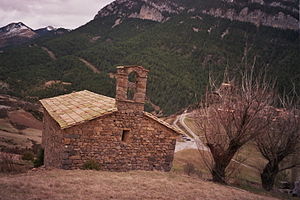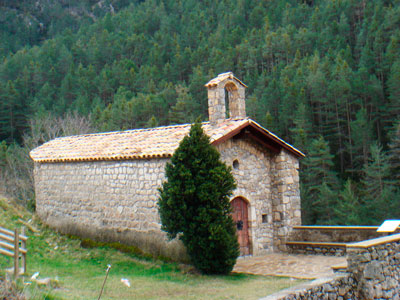One of the main characteristics of the historical and architectural ensemble in Alt Urgell is the Romanesque, and in our valleys we find a very important number of churches of this style, and altarpieces from the Gothic period, forming a unique altarpiece set which is still spoken in its original place after the Civil War. We propose a Romanesque route through our valleys.
Romanesque is characterized by churches of low height, narrow windows, rounded apses at the back, wide walls and semicircular arches. But what better way to distinguish them than to meet them in person? We make a collection of the different Romanesque churches and hermitages in the Vall de la Vansa and Tuixent, with their characteristics and Gothic altarpieces that you will find. The list is in order to be able to create your Romanesque route.
Location : On the outskirts of Josa de Cadí.
Date : 12th century
Characteristics : A covered ship with barrel vault. Semicircular apse with central window and buttress. Bell tower with a single opening

Location : Josa de Cadí.
Date : 19th century
Characteristics : Rectangular plan with three naves separated by arches on cruciform pillars. Square-based belfry with four semi-circular windows. Built on the remains of the castle of Josa.
Location : Carretera de Josa to Tuixent.
Date : 993. Restored in 1983
Characteristics : A single floor, about ten meters long, located next to the river. Gable roof of tile. Semicircular apse. A single window

Location : Municipality of Tuixent.
Date : XI century
Characteristics : A single covered nave with barrel vault and side chapels. Gate with semicircular arch. Bell tower with a square plan, in the past it ended in a spike but was burned by the impact of lightning. It preserves a polychrome Romanesque carving dating from the 12th century and the altarpiece of Sant Martí from 1577, painted by the mysterious “Master of Tuixent”.

Location : Around Fórnols. To get there you need to take a track after the municipality of Montargull.
Date : 12th century
Characteristic : Isolated hermitage. Romanesque construction of a single covered nave with barrel vault and semicircular apse. Espadaña of a single opening. It has Joys intended for the Virgin Mary of Sant Jaume.

Location: Sorribes de la Vansa
Characteristics: A rectangular nave covered with a barrel vault. Square bell tower. Here is preserved the great altarpiece of Sant Julià dels Garrics, work from the end of the 16th century.

Location : Sant Pere de la Vansa
Date : 1031
Characteristics : A covered ship with barrel vault. half dot window Apse deepened and raised. Two-eyed bell tower with an addition for a third bell.

Location : Ossera
Date : 17th century
Characteristics : Small in size, only 5 meters wide. A single nave with a semicircular apse and vaulted roof; has lateral buttresses. Bell bell with two unequal eyes. Inside you can find the Gothic altarpiece of Sant Martí, which was hidden by the neighbors during the Civil War, which has been restored and re-placed on the high altar.

Location : Colldarnat.
Characteristic : Rectangular chapel with barrel-vaulted roof. A bull’s eye over the entrance and a belfry without a bell. Tiled roof The altar and the niche of the Saint can still be found.
Location : Near Barceloneta and Colldarnat
Date : 11th century
Characteristics : Rectangular nave attached to a slightly trapezoidal sanctuary. Romanesque and pre-Romanesque style. It has been quite modified, it is located on a hill with good views of the Lavansa river.

Location: Near Sisquer.
Date: XI and XII century
Characteristics: A single nave with semicircular apse and barrel vault. Two-eyed warbler. The most characteristic feature of the building is the south facade ornamented in six series of two Lombard arches between pilasters made of pumice stone and two double-slit windows. The altarpiece is preserved in the church of Sant Martí in Sorribes de la Vansa. More features .

Location : Sisquer.
Date : 12th century
Characteristics : Semicircular apse, scaffolding on the rock.
Location : Banyeres (abandoned village)
Date : 849
Characteristics : Abandoned church. A single ship, with barrel-vaulted roof. Semicircular apse. Door of a half dovetail stitch, a bull’s eye. One-eyed steeple, half collapsed.
Location : Adraén.
Date : 10th century
Characteristics : A single nave, covered by three sections of cross vault. Semi-circular door. Roof tile. Bell bell with two eyes. Inside is a wooden heart.
Location: Pista de Sant Salvador, on the outskirts of Adraén.
Date: 1500
Characteristics: It is located in the middle of the forest, in the Serra del Cadí, at an altitude of 1690 meters. Construction of a single ship, with double-sided wooden frame roof. half point gate Neither apse nor bell tower. Modernly reconstructed. Gathering on the first Sunday of August.
Location : Fórnols.
Date : Possible date of construction 1752
Characteristics : Baroque building with a single rectangular nave with a barrel vault; in the part of the presbytery it has a cross vault. It preserves a Romanesque wall. Four-sided slate bell tower forming a needle and there is the old clock. Inside there is an ancient Gothic altarpiece of the enthroned figure of Saint Clement

Location : Cornellana.
Date : 1818
Characteristic : Modern construction, dating from 1818, which was built with the stones of the old Romanesque chapel on the outskirts of the village. A single nave with three square apses covered with a cross vault and pre-absidal arches. It has a bell tower with two eyes on the facade, where a portal and a half-point window open. Baroque design interior. Inside there are two Gothic altarpieces: that of Sant Pere and that of the Joys of the Virgin.

Location: La Seu d’Urgell.
Date : 12th century
Characteristic: The only fully Romanesque cathedral in Catalonia. Building of three naves surmounted by a wide transept with five apses and original upper galleries that extend outside the main apse, a characteristic of its influence of Lombard Romanesque art. Central nave covered with barrel vault. The side aisles are covered with a cross vault. It has 4 towers: the clock tower, a two-story bell tower, the Sant Salvador tower and the Sant Just tower. It contains a 13th century polychrome carving of Our Lady of Urgell and an altarpiece of Sant Ermengol. Rectangular cloister with a row of columns in each gallery and fifty capitals in the arches.

There’s a lot to visit, isn’t there? So we recommend booking a room in Cal Gabriel and Cal Farragetes to enjoy all our architectural heritage with the peace of mind you deserve.
Sources: wikipedia , Turisme Alt Urgell and documentary fund of the valleys.